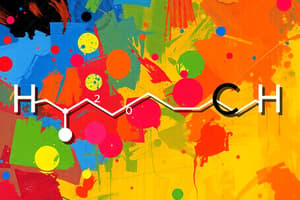Podcast
Questions and Answers
What is the product formed when nitriles react with Grignard or organolithium reagents?
What is the product formed when nitriles react with Grignard or organolithium reagents?
- Aldehyde
- Amine
- Ketone (correct)
- Imine
The hydrolysis of an imine involves replacing a C=N bond with a C=O bond.
The hydrolysis of an imine involves replacing a C=N bond with a C=O bond.
True (A)
What reagents are required to convert a nitrile into a ketone?
What reagents are required to convert a nitrile into a ketone?
Grignard reagent or organolithium reagent
In the reaction of nitriles with organometallic reagents, the polarized C—N triple bond is subjected to __________ addition.
In the reaction of nitriles with organometallic reagents, the polarized C—N triple bond is subjected to __________ addition.
Match the following processes with their corresponding products:
Match the following processes with their corresponding products:
What is formed when a nitrile is treated with LiAlH4 followed by H2O?
What is formed when a nitrile is treated with LiAlH4 followed by H2O?
DIBAL-H treatment of a nitrile yields a primary amine directly.
DIBAL-H treatment of a nitrile yields a primary amine directly.
What is the general structural formula of nitriles?
What is the general structural formula of nitriles?
The mechanism of nitrile hydrolysis involves replacing three C—N bonds with ___ C—O bonds.
The mechanism of nitrile hydrolysis involves replacing three C—N bonds with ___ C—O bonds.
Match the reagents with their corresponding outcomes when reacting with nitriles:
Match the reagents with their corresponding outcomes when reacting with nitriles:
Which of the following statements about nitriles is true?
Which of the following statements about nitriles is true?
Imidic acids and amides can interconvert by treatment with either acid or base.
Imidic acids and amides can interconvert by treatment with either acid or base.
What is the result of hydride addition to a nitrile using DIBAL-H?
What is the result of hydride addition to a nitrile using DIBAL-H?
What is the main purpose of using DIBAL-H in organic synthesis?
What is the main purpose of using DIBAL-H in organic synthesis?
Lithium Aluminium Hydride (LiAlH4) is a strong reducing agent and can reduce nitriles to primary amines.
Lithium Aluminium Hydride (LiAlH4) is a strong reducing agent and can reduce nitriles to primary amines.
What is the product formed when a Grignard reagent reacts with a carbonyl compound?
What is the product formed when a Grignard reagent reacts with a carbonyl compound?
The reaction of an aldehyde with ammonia forms an ______.
The reaction of an aldehyde with ammonia forms an ______.
Match the reagents with their corresponding reactions:
Match the reagents with their corresponding reactions:
Which of the following reactions does not lead to imine formation?
Which of the following reactions does not lead to imine formation?
The reaction of a nitrile with Grignard reagents results in the formation of a ketone.
The reaction of a nitrile with Grignard reagents results in the formation of a ketone.
What is a common application of reducing agents like LiAlH4 in organic chemistry?
What is a common application of reducing agents like LiAlH4 in organic chemistry?
In the presence of water, the reaction of a Grignard reagent with an aldehyde produces a ______.
In the presence of water, the reaction of a Grignard reagent with an aldehyde produces a ______.
Match the following reduction reactions to their respective reagents:
Match the following reduction reactions to their respective reagents:
Flashcards
Hydrolysis of Imine
Hydrolysis of Imine
The process of breaking down an imine using water, replacing the C=N bond with a C=O bond, forming a ketone.
Nitrile Reaction with Organometallics
Nitrile Reaction with Organometallics
Organometallic reagents (Grignard/organolithium) react with nitriles to form ketones, creating a new carbon-carbon bond via nucleophilic addition, followed by hydrolysis.
Nucleophilic Addition to nitriles
Nucleophilic Addition to nitriles
Organometallic reagents add to the polarized C-N triple bond of nitriles forming an anion, subsequently protonated with water, forming an imine.
Reagent Reaction (Sodium Bicarbonate)
Reagent Reaction (Sodium Bicarbonate)
Signup and view all the flashcards
Reagent Reaction (Ammonia)
Reagent Reaction (Ammonia)
Signup and view all the flashcards
Amide hydrolysis (acid)
Amide hydrolysis (acid)
Signup and view all the flashcards
Amide hydrolysis (base)
Amide hydrolysis (base)
Signup and view all the flashcards
Nitrile structure
Nitrile structure
Signup and view all the flashcards
Nitrile preparation
Nitrile preparation
Signup and view all the flashcards
Nitrile hydrolysis (general)
Nitrile hydrolysis (general)
Signup and view all the flashcards
Nitrile hydrolysis mechanism
Nitrile hydrolysis mechanism
Signup and view all the flashcards
Nitrile reduction (LiAlH4)
Nitrile reduction (LiAlH4)
Signup and view all the flashcards
Nitrile reduction (DIBAL-H)
Nitrile reduction (DIBAL-H)
Signup and view all the flashcards
Grignard Reagent with Nitrile
Grignard Reagent with Nitrile
Signup and view all the flashcards
Lithium Aluminum Hydride (LiAlH4) with Nitrile
Lithium Aluminum Hydride (LiAlH4) with Nitrile
Signup and view all the flashcards
Hydrolysis of Nitrile to Carboxylic Acid
Hydrolysis of Nitrile to Carboxylic Acid
Signup and view all the flashcards
Acid Catalyzed Ester Hydrolysis
Acid Catalyzed Ester Hydrolysis
Signup and view all the flashcards
Base Catalyzed Ester Hydrolysis
Base Catalyzed Ester Hydrolysis
Signup and view all the flashcards
Amide Hydrolysis with Acid
Amide Hydrolysis with Acid
Signup and view all the flashcards
Amide Hydrolysis with Base
Amide Hydrolysis with Base
Signup and view all the flashcards
Conversion of Carboxylic Acid to Acid Chloride
Conversion of Carboxylic Acid to Acid Chloride
Signup and view all the flashcards
Conversion of Carboxylic Acid to Ester
Conversion of Carboxylic Acid to Ester
Signup and view all the flashcards
Conversion of Carboxylic Acid to Amide
Conversion of Carboxylic Acid to Amide
Signup and view all the flashcards
Study Notes
Carboxylic Acid Derivatives
- Carboxylic acids have a general structure with a carbonyl group (C=O) and a hydroxyl group (OH).
- Acyl group: The carbon chain attached to the carbonyl group
- Electronegative atom (Z): The atom bonded to the carbonyl carbon in derivatives, impacting acid/base properties
- Common derivatives include: acid chlorides, anhydrides, esters, amides, and nitriles.
Types of Carboxylic Acid Derivatives
- Acid Chlorides:
- General structure: R-C(=O)-Cl
- React readily with nucleophiles, forming substitution products.
- Often form HCl as a byproduct which must be neutralized.
- Anhydrides:
- General structure: R-C(=O)-O-C(=O)-R
- Formed from the dehydration of two carboxylic acid molecules.
- React with nucleophiles, resulting in the carbonyl group of the anhydride breaking the bond
- The nucleophile attacks one carbonyl group and the carbonyl from the other part is the leaving group
- Esters:
- General structure: R-C(=O)-OR'
- Formed by the condensation reaction of a carboxylic acid with an alcohol.
- Hydrolysis can be performed by acid or base, to form a carboxyl and alcohol.
- Amides:
- General structure: R-C(=O)-NR'R"
- Formed by the reaction of a carboxylic acid with ammonia or amines
- Exist in two tautomeric forms that interconvert, with the amide form usually being more stable.
- Nitriles:
- General structure: R-C≡N
- Prepared by SN2 reactions of unhindered methyl and 1° alkyl halides with CN.
- Involve hydrolysis reactions to form carboxylic acids.
Reactions of Carboxylic Acid Derivatives
- Nucleophilic Acyl Substitution:
- Characterizes the reactions of carboxylic acid derivatives
- Involves the nucleophilic attack at the carbonyl carbon, following by loss of the leaving group.
- Oxygen nucleophiles: Can react to form anhydrides, carboxylic acids or esters
- Nitrogen nucleophiles: Can react to form amides.
Anhydrides
- Types of anhydrides:
- Symmetrical Anhydride: "Two R Groups are the same."
- Mixed Anhydride: "Two R Groups are different."
- Cyclic Anhydride: "Cyclic" structures.
Amides
- Types of amides:
- Primary Amide: One C-N bond.
- Secondary Amide: Two C-N bonds.
- Tertiary Amide: Three C-N bonds.
Cyclic Esters and Amides
- Lactones: Cyclic esters.
- Lactams: Cyclic amides.
Structure and Bonding
- The carbonyl group (C=O) is sp2 hybridized, making it trigonal planar
- The electronegative oxygen atom polarizes the carbonyl group, making the carbonyl carbon electrophilic
- Three resonance structures stabilize carboxylic acid derivatives by delocalizing electron density.
Stability of Carboxylic Acid Derivatives
- Stability increases with increasing basicity of Z
Acid Chlorides Reactions
- Acid chlorides readily react with nucleophiles to form nucleophilic substitution products.
- A weak base (like pyridine) is usually required to neutralize the byproduct strong acid HCl.
Nomenclature
- Specific names and abbreviations exist for different types of carboxylic acid derivatives and nitriles.
IR Spectroscopy
- Provides characteristic absorption frequencies for carbonyl groups. Frequency data varies by derivative type
Acid-Catalyzed Hydrolysis
- Mechanisms for converting esters and amides into carboxylic acid involve protonation and loss of an OH or NH2 group.
Base-Promoted Hydrolysis (Saponification)
- Base-promoted hydrolysis results in the formation of a carboxylate anion.
Reactions of Nitriles
- Hydrolysis reactions form carboxylic acids or carboxylate anions
- Reduction with LiAlH4 forms a primary amine.
- Reduction with DIBAL-H forms an aldehyde.
- Organometallic reagents add to the nitrile group resulting in ketones.
Carboxylic Acid Reactions
- Carboxylic acids behave as acids in water, neutralizing bases to form carboxylate salts.
- Other reactions form functional derivatives from the carboxylic acid.
Resonance Stabilization of Carboxylates
- Resonance stabilization plays a crucial role in the equilibrium of the reaction.
Summary
- Carboxylic acid derivatives, such as acid chlorides, anhydrides, esters, amides, and nitriles, exhibit distinct properties and reactivity patterns.
Studying That Suits You
Use AI to generate personalized quizzes and flashcards to suit your learning preferences.




